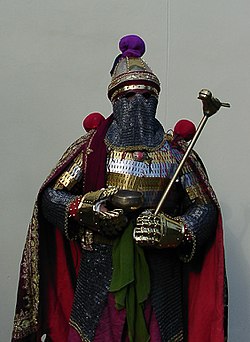
Back إصبهبذ Arabic Ishpabadh Catalan Spahbod German Spahbod Spanish Spahbod Basque اسپهبد Persian Spahbod French Spahbod Italian スパーフベド Japanese Spahbodas Lithuanian

| Military of the Sasanian Empire |
|---|
| Armed forces and units |
| Ranks |
| Defense lines |
| Conflicts |
Spāhbad (also spelled spahbod)[1] is a Middle Persian title meaning "army chief" used chiefly in the Sasanian Empire. Originally there was a single spāhbad, called the Ērān-spāhbed, who functioned as the generalissimo of the Sasanian army. From the time of Khosrow I (r. 531–579) on, the office was split in four, with a spāhbad for each of the cardinal directions.[2] After the Muslim conquest of Persia, the spāhbed of the East managed to retain his authority over the inaccessible mountainous region of Tabaristan on the southern shore of the Caspian Sea, where the title, often in its Islamic form ispahbedh (Persian: اسپهبذ; in Arabic: اصبهبذ ʾiṣbahbaḏ), survived as a regnal title until the Mongol conquests of the 13th century.[3] An equivalent title of Persian origin, ispahsālār or sipahsālār, gained great currency across the Muslim world in the 10th–15th centuries.
The title was also adopted by the Armenians (Armenian: սպարապետ, [a]sparapet) and the Georgians (Georgian: სპასპეტი, spaspeti), as well as Khotan (spāta) and the Sogdians (spʾdpt) in Central Asia. It is also attested in Greek sources as aspabedēs (ἀσπαβέδης).[2][3] The title was revived in the 20th century by the Pahlavi dynasty, in the Modern Persian form sepahbod (سپهبد), equivalent to a three-star Lieutenant General, ranking below arteshbod (full General).
- ^ Frye, Richard N (1984), The History of Ancient Iran, C.H.Beck, p. 224, ISBN 9783406093975
- ^ a b Gyselen (2004)
- ^ a b Bosworth (1978), pp. 207–208
© MMXXIII Rich X Search. We shall prevail. All rights reserved. Rich X Search